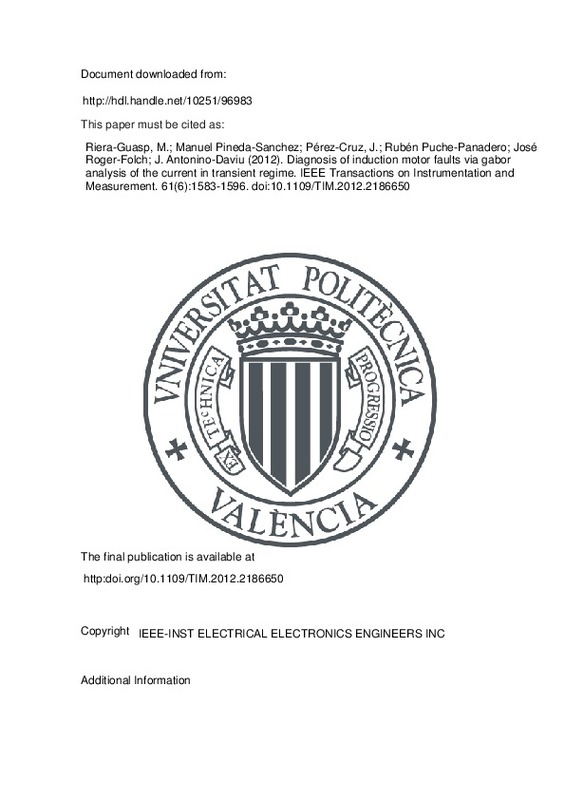Riera-Guasp, M.; Pineda-Sanchez, M.; Pérez-Cruz, J.; Puche-Panadero, R.; Roger-Folch, J.; Antonino-Daviu, J. (2012). Diagnosis of induction motor faults via gabor analysis of the current in transient regime. IEEE Transactions on Instrumentation and Measurement. 61(6):1583-1596. https://doi.org/10.1109/TIM.2012.2186650
Por favor, use este identificador para citar o enlazar este ítem: http://hdl.handle.net/10251/96983
|
Título:
|
Diagnosis of induction motor faults via gabor analysis of the current in transient regime
|
|
Autor:
|

 Riera-Guasp, Martín
Riera-Guasp, Martín

 Pineda-Sanchez, Manuel
Pineda-Sanchez, Manuel

 Pérez-Cruz, Juan
Pérez-Cruz, Juan

 Puche-Panadero, Rubén
Roger-Folch, José
Puche-Panadero, Rubén
Roger-Folch, José

 Antonino-Daviu, J.
Antonino-Daviu, J.
|
|
Entidad UPV:
|
Universitat Politècnica de València. Departamento de Ingeniería Eléctrica - Departament d'Enginyeria Elèctrica
|
|
Fecha difusión:
|
|
|
Resumen:
|
[EN] Time-frequency analysis of the transient current in induction motors (IMs) is the basis of the transient motor current signature analysis diagnosis method. IM faults can be accurately identified by detecting the ...[+]
[EN] Time-frequency analysis of the transient current in induction motors (IMs) is the basis of the transient motor current signature analysis diagnosis method. IM faults can be accurately identified by detecting the characteristic pattern that each type of fault produces in the time-frequency plane during a speed transient. Diverse transforms have been proposed to generate a 2-D time-frequency representation of the current, such as the short time Fourier transform (FT), the wavelet transform, or the Wigner-Ville distribution. However, a fine tuning of their parameters is needed in order to obtain a high-resolution image of the fault in the time-frequency domain, and they also require a much higher processing effort than traditional diagnosis techniques, such as the FT. The new method proposed in this paper addresses both problems using the Gabor analysis of the current via the chirp z-transform, which can be easily adapted to generate high-resolution time-frequency stamps of different types of faults. In this paper, it is used to diagnose broken bars and mixed eccentricity faults of an IM using the current during a startup transient. This new approach is theoretically introduced and experimentally validated with a 1.1-kW commercial motor in faulty and healthy conditions. © 2012 IEEE.
[-]
|
|
Palabras clave:
|
Fault diagnosis
,
Fourier transforms (FTs)
,
Induction motors (IMs)
,
Broken bar
,
Chirp z-transform
,
Gabor analysis
,
High resolution image
,
Mixed eccentricity
,
Motor current signature analysis
,
Short time Fourier transforms
,
Time frequency analysis
,
Transient regime
|
|
Derechos de uso:
|
Reserva de todos los derechos
|
|
Fuente:
|
IEEE Transactions on Instrumentation and Measurement. (issn:
0018-9456
)
|
|
DOI:
|
10.1109/TIM.2012.2186650
|
|
Editorial:
|
IEEE-INST ELECTRICAL ELECTRONICS ENGINEERS INC
|
|
Versión del editor:
|
http:doi.org/10.1109/TIM.2012.2186650
|
|
Código del Proyecto:
|
info:eu-repo/grantAgreement/MICINN//DPI2011-23740/ES/DESARROLLO DE TECNICAS DE DIAGNOSTICO DE AVERIAS INCIPIENTES EN AEROGENERADORES, MEDIANTE EL ANALISIS TIEMPO-FRECUENCIA DE MAGNITUDES ELECTRICAS/
|
|
Descripción:
|
© 2011 IEEE. Personal use of this material is permitted. Permissíon from IEEE must be obtained for all other uses, in any current or future media, including reprinting/republishing this material for advertisíng or promotional purposes, creating new collective works, for resale or redistribution to servers or lists, or reuse of any copyrighted component of this work in other works.
|
|
Agradecimientos:
|
This work was supported by the Spanish Ministerio de Ciencia e Innovacion (MICINN) in the framework of the VI Plan Nacional de Investigacion Cientifica, Desarrollo e Innovacion Tecnologica 2008-2011. (Programa Nacional de ...[+]
This work was supported by the Spanish Ministerio de Ciencia e Innovacion (MICINN) in the framework of the VI Plan Nacional de Investigacion Cientifica, Desarrollo e Innovacion Tecnologica 2008-2011. (Programa Nacional de proyectos de Investigacion Fundamental, project reference DPI2011-23740). The Associate Editor coordinating the review process for this paper was Dr. Subhas Mukhopadhyay.
[-]
|
|
Tipo:
|
Artículo
|







![[Cerrado]](/themes/UPV/images/candado.png)


